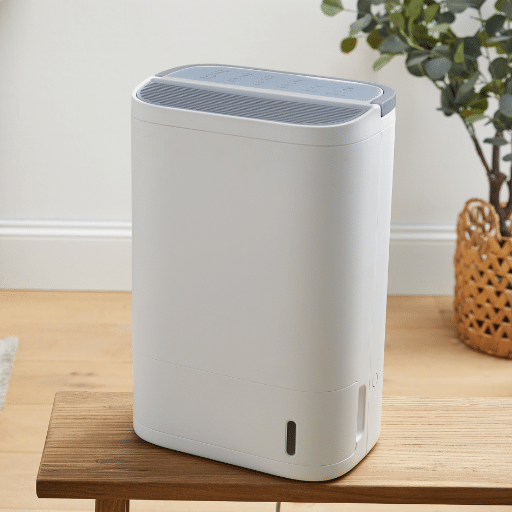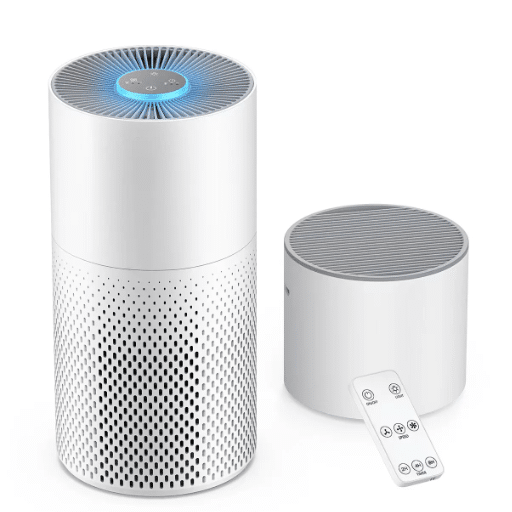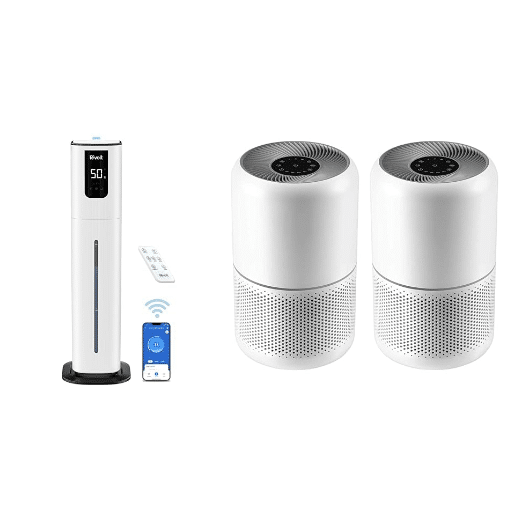Allergies can change the air you breathe from the source of relief to the trigger of discomfort and frustration. The management of indoor air quality is very important for the allergic reactions mitigation, and two common tools used in this process are humidifiers and dehumidifiers. The question arises as to which one has the more positive impact on allergy sufferers.
The current paper will look into the reason and working of each device, reflecting on their effect on allergy symptoms and the proper times for their use in order to achieve the respiratory health supportive environment. By the end of the article, you will be able to comprehend clearly which remedy is most suitable for your situation, depending on your particular allergy triggers and the environmental conditions.
Understanding Allergies and Humidity

The humidity in the air usually plays a great role in determining the severity of allergies as it directly affects the presence of common allergens like mold, dust mites, and pollen. The high level of humidity is the best condition for mold and dust mites which makes the allergy symptoms like sneezing, stuffy nose and eye itchiness worse. On the other hand, low humidity may cause the dryness of nasal passages and skin, which irritates and makes a person more prone to allergens.
The Role of Humidity in Allergies
Research indicates that the right humidity levels will play a major role in the maximum allergic reactions. As far as the high humidity levels (above 60%) are concerned, such places will be full of dust mites and mold which are among the indoor allergens. On the other hand, very dry air can lead the mucous membranes to become dried out, thus, losing their efficiency in capturing and allergy trapping and, eventually, causing more irritation.
Medical research and top-searched sources all agree that the installation of a humidifiers-dehumidifiers system combination could be a great help in reaching the indoor humidity levels of 30%-50% which are recommended. Providing a modern air purifier with a built-in humidity sensor is also a high-tech solution.
How Allergy Symptoms are Affected by Humidity Levels
| Humidity Level | Impact on Allergies | Common Issues |
|---|---|---|
| High (Above 60%) | Creates perfect environment for allergen growth | Mold, dust mites, asthma, allergic rhinitis, chronic sinusitis |
| Optimal (30-50%) | Minimizes allergen growth and respiratory irritation | Balanced environment, comfortable breathing |
| Low (Below 30%) | Dries out nasal passages and reduces natural defense | Nasal irritation, dry skin, reduced allergen trapping |
Identifying Ideal Humidity for Allergy Relief
It has been shown that indoor humidity control of 30%-50% is essential for the alleviation of allergy symptoms as well as the creation of less attractive surroundings for allergens like dust mites, mold, and mildew. This range, which is recognized by the Environmental Protection Agency (EPA) and the World Health Organization (WHO), among others, is thought to be most effective in keeping allergens under control, as well as in providing an air that is not too dry and irritating to the mucous tissues.
The latest humidity detection devices and smart home set-ups allow users to very precisely control these levels while keeping to the scientifically supported rules for allergy relief and the general quality of indoor air.
Humidifiers: Benefits and Functions
Humidifiers play an important role in keeping the indoor air healthy by controlling the humidity, which is a factor that influences health and comfort. Various studies have found that the recommended indoor humidity of 30-50%, as per the health authorities’ like EPA and WHO, can significantly reduce and control these problems along with the lowering of certain viruses’ survival rate in the air.
How Humidifiers Alleviate Allergy Symptoms
The role of humidifiers in relieving allergy symptoms is pivotal, since they tackle the two major problems—dry air and irritant particles. According to scientific studies, the recommended indoor humidity level of 30%-50% can alleviate nasal and throat dryness, which is a common cause for aggravating allergy symptoms.
Key benefits of humidifiers for allergy relief:
- Prevent nasal and throat areas from getting dried out too much, lessening irritation
- Make breathing easier for allergy sufferers
- Help reduce pollen and dust dispersal by weighing down micro particles so they fall instead of floating
- Maintain optimal moisture levels in mucous membranes for natural allergen trapping
Choosing the Right Humidifier with a Filter
Picking the best humidifier that needs a filter calls for a step-by-step process which takes into account the recent technology and the needs of the user. Based on the most recent information from searches and expert reviews, the most important considerations are:
- Room size: For small to medium areas, tables or portable devices with HEPA or advanced anti-microbial filters are recommended
- Filter efficiency: Look for activated carbon and standard-heated filters that effectively purify air
- Maintenance requirements: Consider filter change simplicity and frequency
- Noise levels: Important for bedroom or quiet living spaces
- Energy efficiency: Look for energy-certified models to reduce operating costs
- Smart features: Auto-humidity sensors and smart controls for precise monitoring
Best Practices for Using a Humidifier Indoors
Using a humidifier in a proper way will guarantee not only the best performance but also the safety of the users. Follow these essential best practices:
- Maintain proper humidity levels: Keep indoor humidity between 30-50% using a hygrometer
- Daily cleaning: Empty, wash, and dry the water tank every day
- Weekly deep cleaning: Clean with mild disinfectant or white vinegar at least once a week
- Replace filters regularly: Follow manufacturer’s instructions for filter replacement
- Use distilled water: Prevents mineral residue formation and white dust production
- Proper placement: Place on a flat, raised surface away from walls or direct heat
- Monitor humidity: Use built-in humidistats or smart controls for automatic adjustment
Dehumidifiers: Benefits and Functions

Dehumidifiers are indispensable for keeping the indoor environment to a desirable level, especially in areas that are constantly humid. Their operation is simple: they eliminate moisture in the air and, at the same time, tackle the problems caused by humidity which include mold growth, dust mites, and even moisture-damaged structures.
New research has found that damp and humid indoor environments can worsen respiratory problems such as asthma and allergies; therefore, dehumidifiers are not just anything, but must-have devices for people who are very particular about their health.
The Impact of Dehumidifiers on Allergy Symptoms
Through their functioning, dehumidifiers contribute to the alleviation of allergy symptoms by taking on directly one of the major causes, which is excess moisture in the indoors. The conditions created by high humidity are perfect for the common allergens like dust mites, mold, and mildew to flourish.
How dehumidifiers help with allergies:
- Maintain ideal indoor humidity range of 30-50%
- Significantly reduce allergen activity
- Prevent mold and mildew growth
- Control dust mite populations
- Improve respiratory health and comfort
- Reduce workload on air conditioning units, leading to energy savings
Choosing a Dehumidifier for Optimal Indoor Air Quality
To pick out a dehumidifier for improving indoor air quality, it is indispensable to take into account several paramount technical factors:
| Factor | Considerations |
|---|---|
| Capacity (pints/day) | 30-pint for small areas; 50+ pints for basements or large rooms with serious moisture problems |
| Energy Efficiency | Look for Energy Star certified models for lower operational costs |
| Noise Levels | Measured in decibels; critical for bedrooms and living rooms |
| Smart Features | Adjustable moisture settings, timer control, air purification systems |
| Built-in Hygrometer | Provides accurate humidity monitoring for optimal control |
| Portability | Caster wheels, comfortable handles for easy movement |
| Maintenance | Easy-access water reservoirs or drainage systems |
Using Dehumidifiers Effectively in Allergy-Prone Areas
The Environmental Protection Agency (EPA) recommends keeping indoor humidity levels between 30 to 50%, which can be achieved only through the use of dehumidifiers in allergy-prone areas. High levels of humidity foster the growth of mold, dust mites, and other allergens that cause respiratory problems.
Best practices for dehumidifier placement and use:
- Position in areas most prone to moisture (bathrooms, basements, laundry rooms)
- Use models with built-in hygrometers for precise humidity monitoring
- Clean or replace air filters regularly to remove dust and boost airflow
- Select energy-certified models for lower running costs
- Choose quieter technologies for sensitive living spaces
- Ensure proper maintenance to maximize efficiency
Comparing Humidifiers and Dehumidifiers for Allergy Relief

It is crucial in the allergy relief process to regard both humidifiers and dehumidifiers side by side, and not to take one over the other. Understanding the differences and when to use each device is essential for effective allergy management.
| Feature | Humidifier | Dehumidifier |
|---|---|---|
| Primary Function | Adds moisture to the air | Removes excess moisture from the air |
| Best For | Dry climates, winter months | Humid climates, summer months |
| Ideal Humidity | When levels drop below 30% | When levels exceed 50% |
| Allergy Benefits | Relieves nasal irritation, dry skin, respiratory discomfort | Prevents mold, dust mites, and mildew growth |
| Common Issues Addressed | Dry nasal passages, irritated sinuses, dry skin | Mold growth, dust mites, musty odors |
| Energy Impact | Minimal energy consumption | Can reduce AC workload, saving energy overall |
When to Use a Humidifier vs a Dehumidifier
The decision to utilize either a humidifier or a dehumidifier is depending on the actual moisture levels in the indoor environment and the benefits or drawbacks they bring regarding health and comfort.
🌡️ Use a Humidifier When:
- Indoor relative humidity falls under 30%
- Experiencing irritated sinuses, dry skin, and breathing problems
- During winter months or in dry climates
- Dealing with asthma or allergies worsened by dry air
💧 Use a Dehumidifier When:
- Indoor relative humidity exceeds 50%
- Noticing mold, mildew, or musty odors
- During summer months or in humid climates
- Experiencing allergies triggered by dust mites or mold
Pro Tip: To be more certain about which appliance to use, invest in a hygrometer that provides continuous indoor humidity level readings. This will help you resolve issues with either dryness or humidity and create a healthier, balanced indoor environment.
Factors to Consider for Better Allergy Management
Indoor Air Quality Monitoring
The use of contemporary air quality monitors can yield data in real-time about the levels of particulate matter, volatile organic compounds (VOCs), and humidity. When the sources of pollution or allergens in the house are recognized, solutions can be applied that are specifically designed to that end, like the use of air purifiers with HEPA filtering to eliminate those specific triggers.
Optimal Humidity Levels
Indoor humidity of 30% to 50% is the range that not only human beings but also other living things, such as house dust mites and mould, will feel comfortable and keep their populations at a low level. The use of advanced smart devices like humidifiers and dehumidifiers that can be controlled via Wi-Fi allows for precise humidity control that meets the needs of each season.
Choice of Filtration System
Air purifiers fitted with filters that are of medical standard, such as True HEPA or UV filters, are more effective in removing the allergens like pollen, pet dander and dust. Recent trends indicate that consumers prefer to buy hybrid systems which use HEPA, activated carbon, and ionization technologies together for their air cleaning.
Regular Maintenance
Proper maintenance is a must to eliminate the chances of allergens accumulating in the home systems. HVAC, air purifying, and vacuum cleaning filters should be replaced as per the manufacturer’s recommendations so that the systems operate at peak efficiency.
Final Recommendations for Allergy Sufferers

It is recommended for the people prone to allergies to go for the combination of air purification systems which consists of HEPA filters, carbon layers and ionization technology. This is because the combination of these technologies provides a multi-faceted method of trapping the finest particles, eliminating odors, and neutralizing the allergens in the air.
Key recommendations for optimal allergy relief:
- Invest in quality air purification: Choose systems with HEPA filters, carbon layers, and ionization technology
- Maintain optimal humidity: Keep levels between 30-50% using appropriate devices
- Ensure good air circulation: Promote airflow throughout the house
- Use dehumidifiers when needed: Prevent mold and dust mite growth in humid conditions
- Regular HVAC maintenance: Follow filter replacement schedules as per manufacturer’s recommendations
- Monitor air quality: Use smart sensors and monitoring devices for continuous oversight
References
-
Air Filters, Dehumidifiers, and Humidifiers – University of Rochester Medical Center
This source discusses the importance of dehumidifiers in households with allergies or asthma. -
Humidifiers & Dehumidifiers – University of Massachusetts Environmental Health & Safety
Provides guidance on maintaining indoor air quality and humidity levels to prevent allergens. -
Ten Tips to Tackle Winter Allergies – Columbia University Irving Medical Center
Recommends keeping indoor humidity between 30–40% using humidifiers or dehumidifiers to prevent mold growth.
Frequently Asked Questions (FAQ)
What are the allergy differences between a humidifier and a dehumidifier?
The air in a humidifier becomes more humid whereas a humidifier works opposite by making the air less humid. The humidifier is most useful in dry regions and winter months when heaters are drying out the indoor atmosphere; however, if you have allergies caused by molds and dust mites then the dehumidifier will be a better choice as it is one of the methods for controlling the population of such allergens. Hence, the relief of allergy symptoms will depend upon what sort of allergies one suffers from.
How do humidifiers ease allergy symptoms?
Drying up of nasal passages is one of the symptoms of colds, allergies, and asthma so for these reasons adding moisture to the air with a humidifier can be very helpful. Pretty much in every season of the year, a cool-mist humidifier will be useful but during allergy season, especially the one caused by pollen, it will be more than just necessary.
Can a dehumidifier be of help for allergies?
Certainly, dehumidifiers do help with allergies by taking away from the air the excess moisture. This in turn helps in the humidity control and limits the development of mold and dust mites which aggravate allergy symptoms. Maintained humidity level controversy can be very important for overall allergy management.
Which is the most suitable type of humidifier for allergies?
Ultrasonic & cool mist humidifiers are commonly suggested for allergies as they facilitate the addition of humidity to the air without the drying heat that the environment may be subjected to. Wi warm mist humidifiers, on the other hand, though not as pleasant in hot weather, may still be properly used. Cleaning your humidifier regularly is a must to keep away mold and bacteria from growing.
How does humidity affect allergies?
Humidity heavily influences allergy reactions. For instance, when humidity is at its highest, it’s easy to find people with allergies since spores of molds and dust mites—the major allergy triggers—are around everywhere. In contrast, when the air is dry, people can suffer from respiratory problems and skin irritation. It really is a balancing act with humidifiers and dehumidifiers to keep allergies under control.
Is a purifier for allergies needed with a humidifier?
Moisture content in air is increased with humidifiers, but they cannot remove allergens. A purifier can work alongside a humidifier as it is able to get rid of airborne particles of pollen, dust, pet dander, etc. If both of these devices are used at the same time, it can be said to be a better way of dealing with the problems of environmental allergies.
Are cleaning humidifiers one of the requirements that can lead to allergy symptoms worsening?
Definitely, humidifiers are to be cleaned on a regular basis as this is part of the effective operation and also avoiding them becoming a source of allergens. A humidifier that has not been properly cleaned can be a breeding ground for molds and bacteria which in turn can aggravate the allergy symptoms instead of giving relief.
When should I use a humidifier or dehumidifier to relieve allergies?
A humidifier is needed in dry climate conditions and during winter months when the indoor air is generally very dry. On the other hand, in damp climates or when the outdoor air is excessively moist then a dehumidifier can work to keep the humidity level optimal thus reducing the issues of allergy and asthma. By watching the indoor humidity levels, you will find out which equipment to use for the best comfort and health.



